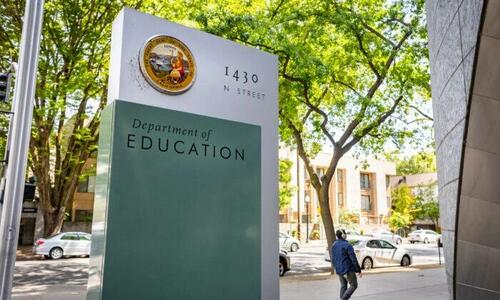
California Officials Ask Schools To Construct Housing For Teachers, Students
Authored by Savannah Hulsey Pointer via The Epoch Times (emphasis ours),
California officials are pushing for school districts to convert available property into housing for teachers, school staff, and, in some cases, students.
State Superintendent of Public Instruction Tony Thurmond hosted a summit on Aug. 14 featuring state leaders to address what his office called the “critical need for affordable housing and workforce housing, and exploring strategies for accelerating access to homeownership for working and middle-class Californians,” according to a news release.
 The California Department of Education in Sacramento, Calif., on April 18, 2022. (John Fredricks/The Epoch Times)
The California Department of Education in Sacramento, Calif., on April 18, 2022. (John Fredricks/The Epoch Times)Thurmond’s housing initiative, announced on July 30, was officially launched at the summit. The initiative’s objective is to use 75,000 acres of surplus land owned by school districts throughout the state to construct 2.3 million housing units.
“California is facing a housing crisis—and it doesn’t have to be. … This initiative [is] all about: activating the resources and expertise that we all have within our great state, so we can make sure that our community members from all walks of life have access to the California Dream.”
The superintendent previously announced financial incentives for districts that take necessary steps to build staff housing, and the California Department of Education has sponsored a workshop for education officials to learn about real estate development.
Thurmond’s program is in accordance with the Teacher Housing Act of 2016, which permits school districts to seek out housing project funding sources, such as federal and state tax credits. Additional legislation, such as a 2022 law that became effective in January, provide added benefits.
Schools could also use the $10 billion school facilities bond, known as Proposition 2, to construct teacher housing and fix classrooms and other buildings if it succeeds this fall.
Some districts have already started working on housing for school employees. Among the properties owned by Los Angeles Unified are a 26-unit building set aside for low-income families and a 90-unit complex that just opened in April.
A 135-unit building is set to debut this fall by San Francisco Unified. A 70-unit development has been held by Santa Clara Unified for almost 20 years.
The San Mateo County Office of Education is working with a nonprofit dedicated to public-private housing to purchase an existing apartment complex for local teachers. The Marin County Office of Education collaborated with the state and the county to construct housing for educators on property held by the state, close to San Quentin Prison.
The Epoch Times has reached out to the California Teachers Association for comment.
This is just one of the changes taking place in California schools. The state introduced a number of new laws governing safety, health, and inclusivity for the upcoming school year.
Among those laws is a recess requirement, which requires public schools to provide at least 30 minutes of recess on regular days and 15 minutes on shortened days to allow students time for physical activity.
Another law prohibits school staff from disclosing a student’s gender identity, sexual orientation, or gender expression to parents without the student’s consent. Additionally, climate change education is now required in science curricula for grades 1–12.
K–12 schools must integrate media literacy into their curricula, helping students critically evaluate media content to help them combat misinformation. Schools serving grades 7–12 must also educate students on the dangers of opioids, including fentanyl, and include this information in their safety plans.
Another change affects suspension policies: Schools can no longer suspend students in grades K–12 for disruptions or defiance. Instead, school administrators must provide in-school interventions or support. Meanwhile, students are now allowed a full day per semester to attend religious events, up from the previous four-hour limit.
The Associated Press and Sophie Li contributed to this report.
Tyler Durden
Sat, 08/17/2024 – 19:50

 1 rok temu
1 rok temu












